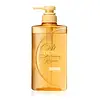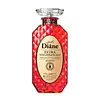What's inside
What's inside
 Key Ingredients
Key Ingredients

 Benefits
Benefits

 Concerns
Concerns

 Ingredients Side-by-side
Ingredients Side-by-side

Water
Skin ConditioningIsopentyldiol
HumectantStearyl Alcohol
EmollientBehentrimonium Chloride
PreservativeGlycerin
HumectantDimethicone
EmollientCetearyl Alcohol
EmollientBehenyl Alcohol
EmollientAminopropyl Dimethicone
Hydrogenated Polyisobutene
EmollientSteartrimonium Chloride
PreservativePolysilicone-13
Camellia Seed Oil
Lactic Acid
BufferingLysine Lauroyl Glutamate
CleansingSqualane
EmollientRoyal Jelly Extract
Skin ConditioningGlycine Max Seed Extract
Skin ConditioningIsopropyl Alcohol
SolventDipropylene Glycol
HumectantIsopropyl Myristate
EmollientPEG-2 Laurate
EmulsifyingSalicylic Acid
MaskingAmodimethicone
PPG-2-Deceth-12
EmulsifyingMethylserine
Skin ConditioningDisodium EDTA
Cetrimonium Chloride
AntimicrobialButylene Glycol
HumectantTocopherol
AntioxidantSodium Benzoate
MaskingPhenoxyethanol
PreservativeParfum
MaskingCI 17200
Cosmetic ColorantCI 15985
Cosmetic ColorantWater, Isopentyldiol, Stearyl Alcohol, Behentrimonium Chloride, Glycerin, Dimethicone, Cetearyl Alcohol, Behenyl Alcohol, Aminopropyl Dimethicone, Hydrogenated Polyisobutene, Steartrimonium Chloride, Polysilicone-13, Camellia Seed Oil, Lactic Acid, Lysine Lauroyl Glutamate, Squalane, Royal Jelly Extract, Glycine Max Seed Extract, Isopropyl Alcohol, Dipropylene Glycol, Isopropyl Myristate, PEG-2 Laurate, Salicylic Acid, Amodimethicone, PPG-2-Deceth-12, Methylserine, Disodium EDTA, Cetrimonium Chloride, Butylene Glycol, Tocopherol, Sodium Benzoate, Phenoxyethanol, Parfum, CI 17200, CI 15985
Water
Skin ConditioningSodium C14-16 Olefin Sulfonate
CleansingLauryl Betaine
CleansingCocamide Methyl Mea
Asparagopsis Armata Extract
Skin ProtectingPropanediol
SolventGamma-Docosalactone
Skin ConditioningQuaternium-33
PEG-32
HumectantPEG-6
HumectantDipropylene Glycol
HumectantGlucosyl Hesperidin
HumectantButylene Glycol
HumectantHydrolyzed Rice Protein
Skin ConditioningGlycerylamidoethyl Methacrylate/Stearyl Methacrylate Copolymer
HumectantSodium Hyaluronate
HumectantSorbitol
HumectantPrunus Domestica Seed Extract
EmollientAscophyllum Nodosum Extract
Skin ConditioningPisum Sativum Sprout Extract
Skin ConditioningKeratin
Skin ConditioningChamomilla Recutita Flower Extract
MaskingSpiraea Ulmaria Flower Extract
Skin ConditioningIsomalt
HumectantPolyquaternium-10
Polyquaternium-7
Hydrolyzed Collagen
EmollientHydrolyzed Keratin
HumectantHydrolyzed Silk
HumectantPCA Ethyl Cocoyl Arginate
MoisturisingHydrolyzed Silk Pg-Propyl Methylsilanediol
Skin ConditioningBiotin
AntiseborrhoeicPouteria Sapota Seed Oil
EmollientPhytosteryl/Octyldodecyl Lauroyl Glutamate
Skin ConditioningSclerocarya Birrea Seed Oil
HumectantTheobroma Grandiflorum Seed Butter
Skin ConditioningMangifera Indica Seed Oil
EmollientUbiquinone
AntioxidantGlycine Soja Sterols
EmollientCeramide Ng
Skin ConditioningArgania Spinosa Kernel Oil
EmollientCeramide Ag
HumectantCeramide NP
Skin ConditioningCeramide AP
Skin ConditioningCeramide EOP
Skin ConditioningChenopodium Quinoa Seed Oil
EmollientCarapa Guaianensis Seed Oil
Skin ConditioningAdansonia Digitata Seed Oil
EmollientSodium Chloride
Masking1,2-Hexanediol
Skin ConditioningCholesterol
EmollientSalicylic Acid
MaskingO-Cymen-5-Ol
AntimicrobialTea-Cocoyl Glutamate
CleansingPotassium Cocoyl Hydrolyzed Keratin
Skin ConditioningQuaternium-18
Behentrimonium Chloride
PreservativePEG-60 Hydrogenated Castor Oil
EmulsifyingGlycerin
HumectantPropylene Glycol
HumectantCitric Acid
BufferingTocopherol
AntioxidantDisodium EDTA
Sodium Benzoate
MaskingPhenoxyethanol
PreservativeParfum
MaskingCaramel
Cosmetic ColorantWater, Sodium C14-16 Olefin Sulfonate, Lauryl Betaine, Cocamide Methyl Mea, Asparagopsis Armata Extract, Propanediol, Gamma-Docosalactone, Quaternium-33, PEG-32, PEG-6, Dipropylene Glycol, Glucosyl Hesperidin, Butylene Glycol, Hydrolyzed Rice Protein, Glycerylamidoethyl Methacrylate/Stearyl Methacrylate Copolymer, Sodium Hyaluronate, Sorbitol, Prunus Domestica Seed Extract, Ascophyllum Nodosum Extract, Pisum Sativum Sprout Extract, Keratin, Chamomilla Recutita Flower Extract, Spiraea Ulmaria Flower Extract, Isomalt, Polyquaternium-10, Polyquaternium-7, Hydrolyzed Collagen, Hydrolyzed Keratin, Hydrolyzed Silk, PCA Ethyl Cocoyl Arginate, Hydrolyzed Silk Pg-Propyl Methylsilanediol, Biotin, Pouteria Sapota Seed Oil, Phytosteryl/Octyldodecyl Lauroyl Glutamate, Sclerocarya Birrea Seed Oil, Theobroma Grandiflorum Seed Butter, Mangifera Indica Seed Oil, Ubiquinone, Glycine Soja Sterols, Ceramide Ng, Argania Spinosa Kernel Oil, Ceramide Ag, Ceramide NP, Ceramide AP, Ceramide EOP, Chenopodium Quinoa Seed Oil, Carapa Guaianensis Seed Oil, Adansonia Digitata Seed Oil, Sodium Chloride, 1,2-Hexanediol, Cholesterol, Salicylic Acid, O-Cymen-5-Ol, Tea-Cocoyl Glutamate, Potassium Cocoyl Hydrolyzed Keratin, Quaternium-18, Behentrimonium Chloride, PEG-60 Hydrogenated Castor Oil, Glycerin, Propylene Glycol, Citric Acid, Tocopherol, Disodium EDTA, Sodium Benzoate, Phenoxyethanol, Parfum, Caramel
 Reviews
Reviews

Ingredients Explained
These ingredients are found in both products.
Ingredients higher up in an ingredient list are typically present in a larger amount.
This ingredient is a preservative and often used for it's anti-static properties. You'll most likely see this ingredient in hair conditioners.
It does not cause irritation or sensitization in leave-on products at 1-5%.
Butylene Glycol (or BG) is used within cosmetic products for a few different reasons:
Overall, Butylene Glycol is a safe and well-rounded ingredient that works well with other ingredients.
Though this ingredient works well with most skin types, some people with sensitive skin may experience a reaction such as allergic rashes, closed comedones, or itchiness.
Learn more about Butylene GlycolDipropylene Glycol is a synthetically created humectant, stabilizer, and solvent.
This ingredient helps:
Dipropylene glycol is technically an alcohol, but it belongs to the glycol family (often considered part of the ‘good’ alcohols). This means it is hydrating and gentle on skin unlike drying solvent alcohols like denatured alcohol.
As a masking agent, Dipropylene Glycol can be used to cover the smell of other ingredients. However, it does not have a scent.
Studies show Dipropylene Glycol is considered safe to use in skincare.
Learn more about Dipropylene GlycolDisodium EDTA plays a role in making products more stable by aiding other preservatives.
It is a chelating agent, meaning it neutralizes metal ions that may be found in a product.
Disodium EDTA is a salt of edetic acid and is found to be safe in cosmetic ingredients.
Learn more about Disodium EDTAGlycerin is already naturally found in your skin. It helps moisturize and protect your skin.
A study from 2016 found glycerin to be more effective as a humectant than AHAs and hyaluronic acid.
As a humectant, it helps the skin stay hydrated by pulling moisture to your skin. The low molecular weight of glycerin allows it to pull moisture into the deeper layers of your skin.
Hydrated skin improves your skin barrier; Your skin barrier helps protect against irritants and bacteria.
Glycerin has also been found to have antimicrobial and antiviral properties. Due to these properties, glycerin is often used in wound and burn treatments.
In cosmetics, glycerin is usually derived from plants such as soybean or palm. However, it can also be sourced from animals, such as tallow or animal fat.
This ingredient is organic, colorless, odorless, and non-toxic.
Glycerin is the name for this ingredient in American English. British English uses Glycerol/Glycerine.
Learn more about GlycerinParfum is a catch-all term for an ingredient or more that is used to give a scent to products.
Also called "fragrance", this ingredient can be a blend of hundreds of chemicals or plant oils. This means every product with "fragrance" or "parfum" in the ingredients list is a different mixture.
For instance, Habanolide is a proprietary trade name for a specific aroma chemical. When used as a fragrance ingredient in cosmetics, most aroma chemicals fall under the broad labeling category of “FRAGRANCE” or “PARFUM” according to EU and US regulations.
The term 'parfum' or 'fragrance' is not regulated in many countries. In many cases, it is up to the brand to define this term.
For instance, many brands choose to label themselves as "fragrance-free" because they are not using synthetic fragrances. However, their products may still contain ingredients such as essential oils that are considered a fragrance by INCI standards.
One example is Calendula flower extract. Calendula is an essential oil that still imparts a scent or 'fragrance'.
Depending on the blend, the ingredients in the mixture can cause allergies and sensitivities on the skin. Some ingredients that are known EU allergens include linalool and citronellol.
Parfum can also be used to mask or cover an unpleasant scent.
The bottom line is: not all fragrances/parfum/ingredients are created equally. If you are worried about fragrances, we recommend taking a closer look at an ingredient. And of course, we always recommend speaking with a professional.
Learn more about ParfumPhenoxyethanol is a preservative that has germicide, antimicrobial, and aromatic properties. Studies show that phenoxyethanol can prevent microbial growth. By itself, it has a scent that is similar to that of a rose.
It's often used in formulations along with Caprylyl Glycol to preserve the shelf life of products.
Salicylic Acid (also known as beta hydroxy acid or BHA) is a well-known ingredient for treating skin that struggles with acne and clogged pores. It exfoliates both the skin's surface and deep within the pores to help clear out buildup, control oil, and reduce inflammation.
Unlike AHAs (alpha hydroxy acids), salicylic acid is oil-soluble. This allows it to penetrate into pores which makes it especially effective for treating blackheads and preventing future breakouts.
Salicylic acid is also known for its soothing properties. It has a similar structure to aspirin and can calm inflamed or irritated skin, making it a good option for acne-prone skin that is also sensitive.
Concentrations of 0.5-2% are recognized by the U.S. FDA as an over-the-counter topical acne product.
It can cause irritation and/or dryness if one's skin already has a compromised moisture barrier, so it's best to focus on repairing that before introducing this ingredient into your routine.
While salicylic acid does not increase sun sensitivity, it’s still important to wear sunscreen daily to protect your skin.
If you are looking for the ingredient called BHA or Butylated Hydroxyanisole, click here.
Learn more about Salicylic AcidSodium Benzoate is a preservative. It's used in both cosmetic and food products to inhibit the growth of mold and bacteria. It is typically produced synthetically.
Both the US FDA and EU Health Committee have approved the use of sodium benzoate. In the US, levels of 0.1% (of the total product) are allowed.
Sodium benzoate works as a preservative by inhibiting the growth of bacteria inside of cells. It prevents the cell from fermenting a type of sugar using an enzyme called phosphofructokinase.
It is the salt of benzoic acid. Foods containing sodium benzoate include soda, salad dressings, condiments, fruit juices, wines, and snack foods.
Studies for using ascorbic acid and sodium benzoate in cosmetics are lacking, especially in skincare routines with multiple steps.
We always recommend speaking with a professional, such as a dermatologist, if you have any concerns.
Learn more about Sodium BenzoateTocopherol (also known as Vitamin E) is a common antioxidant used to help protect the skin from free-radicals and strengthen the skin barrier. It's also fat soluble - this means our skin is great at absorbing it.
Vitamin E also helps keep your natural skin lipids healthy. Your lipid skin barrier naturally consists of lipids, ceramides, and fatty acids. Vitamin E offers extra protection for your skin’s lipid barrier, keeping your skin healthy and nourished.
Another benefit is a bit of UV protection. Vitamin E helps reduce the damage caused by UVB rays. (It should not replace your sunscreen). Combining it with Vitamin C can decrease sunburned cells and hyperpigmentation after UV exposure.
You might have noticed Vitamin E + C often paired together. This is because it is great at stabilizing Vitamin C. Using the two together helps increase the effectiveness of both ingredients.
There are often claims that Vitamin E can reduce/prevent scarring, but these claims haven't been confirmed by scientific research.
Learn more about TocopherolWater. It's the most common cosmetic ingredient of all. You'll usually see it at the top of ingredient lists, meaning that it makes up the largest part of the product.
So why is it so popular? Water most often acts as a solvent - this means that it helps dissolve other ingredients into the formulation.
You'll also recognize water as that liquid we all need to stay alive. If you see this, drink a glass of water. Stay hydrated!
Learn more about Water